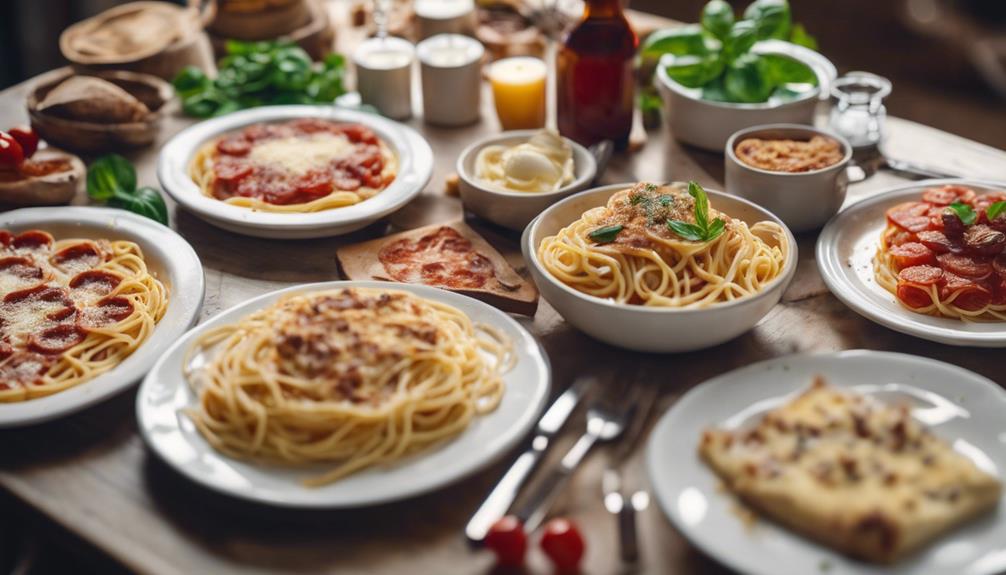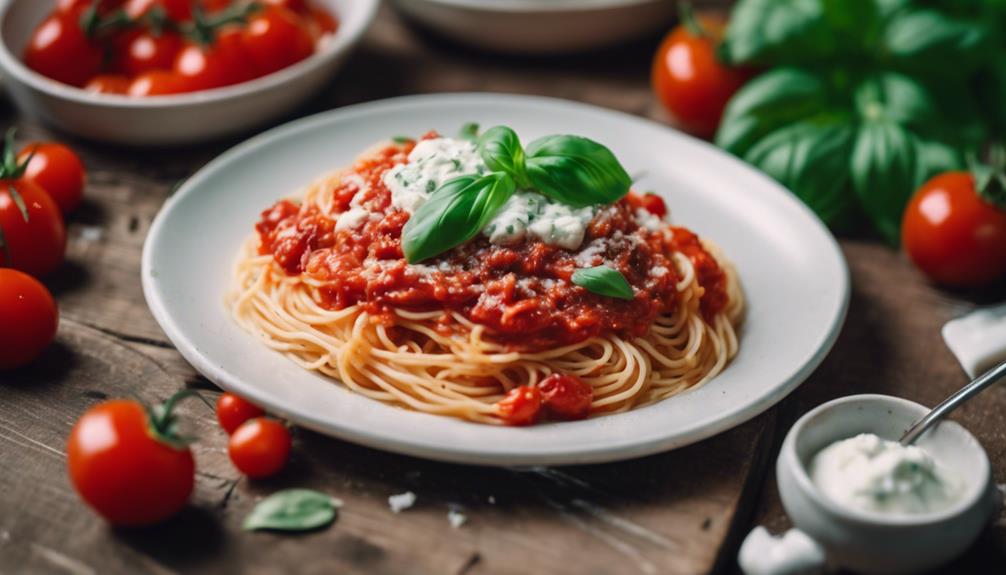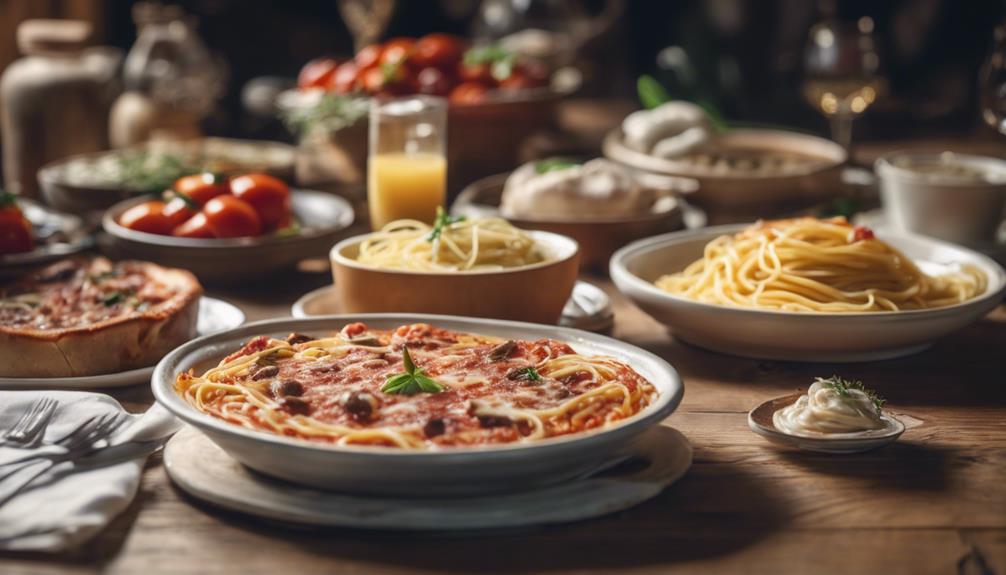Italian cuisine offers a delightful range of dishes! From creamy pasta to cheesy pizzas, Italy has you covered. Don’t forget about iconic desserts like Tiramisu and Cannoli. Each dish showcases regional flavors and influences, making every bite a journey through Italy’s diverse culinary landscape. If you’re interested in the history, ingredients, regional variations, or how Italian food has impacted the world, there’s a lot more to explore!
Key Takeaways
- Italian dishes include pasta variations like spaghetti, lasagna, and risotto.
- Pizza with various toppings is a popular Italian dish worldwide.
- Antipasti, such as bruschetta and prosciutto, are common starters.
- Seafood dishes like seafood linguine and grilled octopus are prevalent in coastal regions.
- Desserts like Tiramisu, Cannoli, and Gelato are iconic in Italian cuisine.
History of Italian Cuisine
Italian cuisine boasts a rich history that traces back to the days of the Roman Empire. Influences from trade along the Silk Road brought diverse ingredients to different regions, shaping unique regional specialties. Sicily, for example, played a significant role in introducing almonds and rice to Italian cuisine, adding depth to the flavors. The Norman invasion in the 12th century also left its mark, bringing innovations like pasta dishes that have become staples today.
Italian food writing, dating back to the 4th century BC, emphasized the significance of quality ingredients and seasonal produce, setting the foundation for the culinary traditions we appreciate today. The fusion of different cultural influences over centuries has given rise to a diverse and vibrant Italian culinary landscape, with each region offering its own distinct flavors and techniques.
Basic Ingredients in Italian Dishes
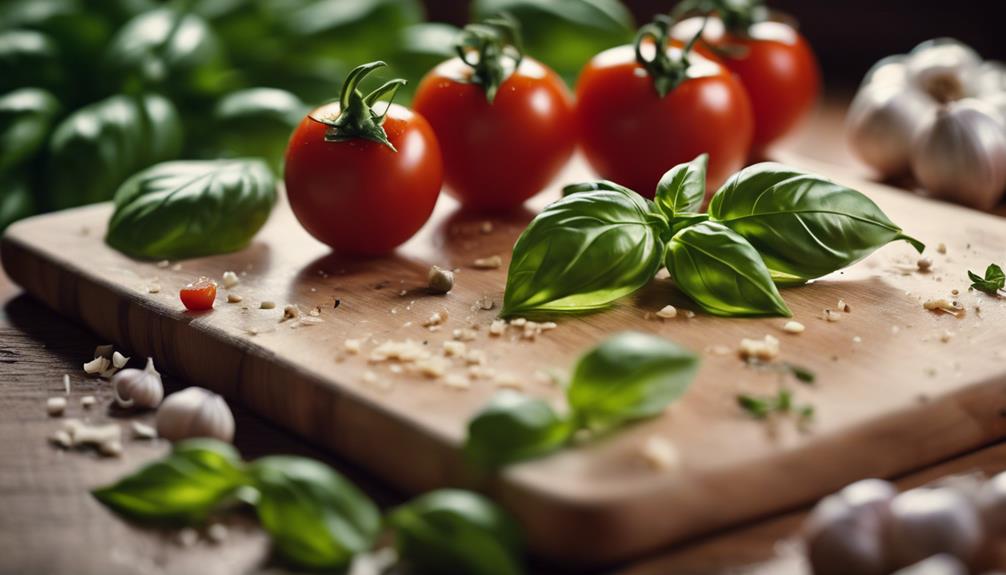
Exploring the heart of Italian dishes, the essential ingredients in this cuisine form the foundation of its rich and diverse flavors. Olive oil, a cornerstone of Italian cooking, isn't just a cooking medium but also a flavor enhancer. Italy's love affair with olive oil is evident in its extensive use across various regional dishes.
Cheeses play a crucial role in Italian cuisine, with over 600 varieties adding depth and complexity to dishes. From the creamy mozzarella to the sharp Parmigiano-Reggiano, cheeses elevate the taste of pasta dishes and antipasti.
Pasta, another Italian staple, comes in countless shapes and sizes, pairing perfectly with traditional sauces like Bolognese and Carbonara. Fresh, seasonal vegetables and quality meats feature prominently in Italian recipes, bringing vibrancy and freshness to the table.
Bread, often served alongside sausages, cured meats, and cheeses, completes the Italian dining experience. The simplicity and quality of these basic ingredients reflect the essence of Italian cuisine – a celebration of fresh flavors and culinary traditions.
Regional Varieties of Italian Cuisine
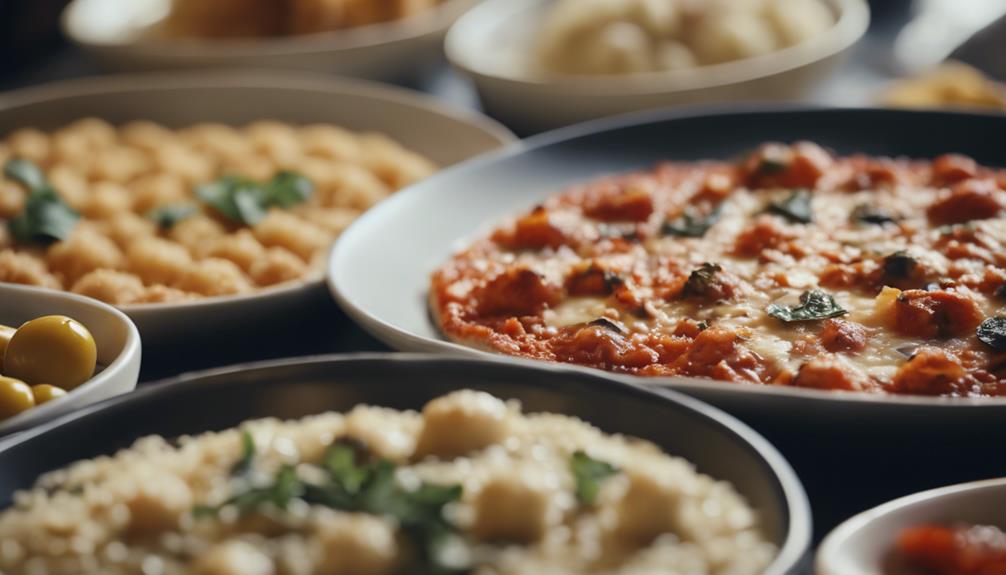
When exploring regional varieties of Italian cuisine, you'll encounter a delightful clash of flavors and culinary traditions.
From North to South, coastal dishes differ from those found inland, offering a diverse gastronomic experience.
Get ready to commence on a flavorful journey through Italy's rich and varied culinary landscape!
North Vs South
In the domain of Italian cuisine, the divide between the North and South becomes evident in their distinct culinary traditions. Northern Italian cuisine leans towards butter, rice, and polenta, showcasing dishes like Risotto alla Milanese and Ossobuco that reflect a heavier, meat-based style.
On the other hand, Southern Italian cuisine embraces olive oil, pasta, and tomatoes with dishes like Pasta alla Norma and Caprese salad, highlighting lighter, vegetable-centric options.
The North boasts rich cheeses such as Parmigiano Reggiano and Gorgonzola, while the South excels in fresh seafood delicacies like Spaghetti alle Vongole and Capesante alla Brace. Northern regions like Piedmont are renowned for their truffle-based dishes, offering a unique culinary experience.
In contrast, Southern regions like Sicily are famous for citrus-infused desserts like Cannoli and Cassata, adding an invigorating touch to the diverse culinary landscape shaped by the North vs South culinary divide.
Coastal Vs Inland
The divide between Coastal and Inland Italian cuisine is marked by contrasting emphasis on seafood and hearty dishes respectively, showcasing the diverse regional varieties of culinary traditions in Italy.
Coastal Italian cuisine, found in regions like Sicily and the Amalfi Coast, thrives on fresh seafood like anchovies, sardines, and squid. These coastal areas infuse their dishes with vibrant flavors of citrus fruits, olives, and capers, reflecting the sunny Mediterranean influences.
On the other hand, Inland Italian cuisine, prevalent in regions such as Tuscany and Emilia-Romagna, leans towards rich pasta dishes and savory cured meats. Here, the focus shifts to heartier ingredients like cheese and meat, creating comforting and robust meals.
The beauty of Italian cuisine lies in the diversity that emerges from the interplay of geography, climate, and local ingredients. Whether you prefer the light and zesty flavors of coastal dishes or the hearty and satisfying meals of inland regions, Italian cuisine offers a delightful journey through a tapestry of flavors and culinary experiences.
Popular Italian Desserts

Italian desserts are a sweet finale to your meal, with classics like Tiramisù and Cannoli stealing the show.
Gelato and Panna Cotta also hold their own, offering creamy and delightful options to satisfy your sweet tooth.
Get ready to indulge in these popular Italian treats that are sure to leave you craving more!
Tiramisu and Cannoli
Indulge in the decadent delights of Tiramisu and Cannoli, two iconic Italian desserts that tantalize the taste buds with their unique flavors and textures.
Tiramisu, hailing from the Veneto region, combines layers of coffee-soaked ladyfingers with creamy mascarpone cheese, creating a luscious dessert that's a true masterpiece in Italian cuisine.
On the other hand, Cannoli, a favorite Sicilian pastry, boasts tube-shaped shells filled with sweet ricotta cheese, often garnished with candied fruit and a sprinkle of powdered sugar or pistachios.
The rich and indulgent flavors of Tiramisu are further enhanced by a dusting of cocoa powder, adding a delightful hint of bitterness to complement its sweetness.
Meanwhile, Cannoli offers a delightful contrast of crispy pastry shell and creamy ricotta filling, sometimes jazzed up with chocolate chips or pistachio cream.
These desserts not only showcase the culinary artistry of Italian pastry-making but also embody the passion and heritage of Italian cuisine in every bite.
Gelato and Panna Cotta
Get ready to savor the creamy delights of Gelato and Panna Cotta, two beloved Italian desserts that are sure to captivate your taste buds. Gelato, a traditional Italian dessert, is known for its dense and creamy texture, achieved through a slower churning process compared to ice cream. On the other hand, Panna Cotta, meaning 'cooked cream' in Italian, offers a silky smooth texture with a delightful burst of flavors. These desserts are a must-try for anyone with a sweet tooth!
Here is a table showcasing some key facts about Gelato and Panna Cotta:
| Aspect | Gelato | Panna Cotta |
|---|---|---|
| Type | Italian dessert | Italian dessert |
| Creaminess | Creamier and denser than ice cream | Silky smooth texture |
| Flavors | Pistachio, hazelnut, stracciatella | Versatile with various flavor options |
| Serving Style | Scoops in a cone or cup | Served in molds, often with fruit or caramel sauce |
Indulge in these delightful treats and experience the true essence of Italian desserts!
Traditional Italian Holiday Foods

During the holiday season in Italy, traditional festive dishes take center stage. Panettone, a delightful sweet bread filled with candied fruits and raisins, is a must-have during Christmas celebrations.
Lentils and Cotechino, a hearty dish often enjoyed on New Year's Eve, symbolize prosperity in the upcoming year.
If you have a sweet tooth, you can't miss trying Struffoli, small fried dough balls drizzled with honey and sprinkles, a classic Italian Christmas dessert.
For those craving something savory, Fried Baccalà, crispy salted codfish dipped in batter and fried to perfection, is a popular choice during the holiday season.
And to satisfy your sweet cravings, indulge in Torrone, a delicious nougat made with honey, sugar, and almonds, enjoyed as a traditional sweet treat during Christmas in Italy.
These dishes not only tantalize your taste buds but also bring a touch of Italian tradition to your holiday celebrations.
Italian Food and International Influence
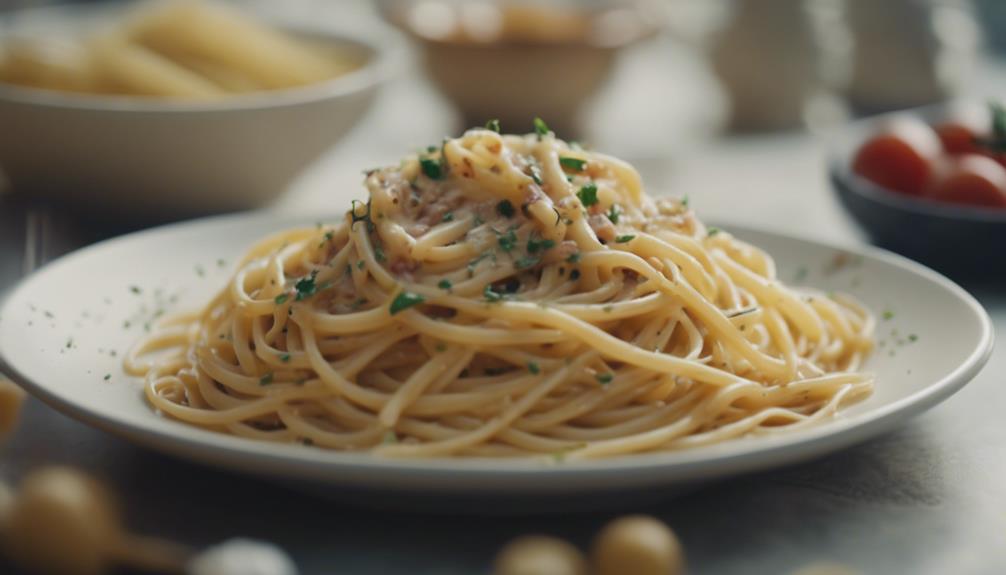
Italian cuisine's global impact is evident through its widespread influence on international gastronomy, prominently exemplified by dishes like pizza and pasta enjoyed worldwide.
The Mediterranean diet, with its emphasis on olive oil, fresh produce, and seafood, serves as the foundation of Italian culinary traditions.
Italian-American cuisine, born from the adaptation of traditional Italian recipes by immigrants in the United States, has added a unique twist to the culinary landscape.
Italian dishes such as lasagna, risotto, and tiramisu are cherished for their distinct flavors and regional variations, showcasing the depth of Italy's culinary heritage.
The country's diverse regional specialties, ranging from Sicilian arancini to Venetian tiramisu, highlight the rich tapestry of flavors and techniques that contribute to the world's love affair with Italian food.
Notable Italian Food Establishments

Which renowned Italian food establishments stand out for their exceptional culinary creations and accolades? Italy is home to some of the world's best Italian culinary experiences, with restaurants like Osteria Francescana in Modena, Enoteca Pinchiorri in Florence, Da Vittorio in Brusaporto, Le Calandre in Rubano, and Albereta in Erbusco leading the pack. These establishments have garnered international acclaim for their dedication to authentic Italian ingredients, innovative Italian recipes, and impeccable service. From the three Michelin-starred Enoteca Pinchiorri offering a vast wine selection to the legendary Gualtiero Marchesi's Albereta showcasing Italian gastronomy at its finest, each of these restaurants provides a unique and unforgettable dining experience. Check out the table below for a quick overview of these notable Italian food establishments:
| Restaurant | Location | Michelin Stars |
|---|---|---|
| Osteria Francescana | Modena | 3 |
| Enoteca Pinchiorri | Florence | 3 |
| Da Vittorio | Brusaporto | 3 |
| Le Calandre | Rubano | 3 |
Iconic Italian Drinks

Explore the world of iconic Italian drinks, known for their distinctive flavors and cultural significance. When it comes to Italian cocktails, the Negroni stands out for its perfect blend of gin, vermouth, and Campari, creating a harmonious balance of sweetness and bitterness. This classic drink not only showcases Italian mixology traditions but also offers an invigorating and robust taste that has gained popularity both in Italy and around the globe.
The Negroni is a classic Italian cocktail made with gin, vermouth, and Campari, known for its balanced flavors. Italian mixology traditions are showcased in the Negroni, with slight variations to adjust sweetness and bitterness. Negroni is a popular drink in Italy and worldwide, appreciated for its strong flavors and invigorating taste.
The Negroni is typically served over ice in a rocks glass, garnished with a twist of orange peel, adding a citrusy aroma to the experience. This iconic Italian cocktail represents the rich history and culture of Italian mixology, enjoyed in bars and restaurants globally.
Frequently Asked Questions
What Are the Top 10 Italian Dishes?
When it comes to the top 10 Italian dishes, you're in for a treat! From classics like pizza and pasta carbonara to regional specialties such as arancini and gelato, Italian cuisine offers a delightful culinary journey. Enjoy!
What Are Traditional Italian Dishes?
As you explore traditional Italian dishes, you'll discover a culinary journey rich in history and flavor. From hearty lasagne to delicate tiramisù, Italy's diverse regions offer a tapestry of tastes that will delight your palate.
What Is an Italian Food Menu?
When planning an Italian food menu, remember to include antipasti, primi piatti, secondi piatti, and dolci. Consider regional specialties like Sicilian arancini or Tuscan ribollita. Use fresh, seasonal ingredients for authentic flavors.
What Is Italy's National Dish?
Italy's national dish is a topic of lively debate, but pasta and pizza reign supreme in the hearts of many. With flavors that dance on your palate, these iconic creations embody the essence of Italian cuisine.
Can Italian Dishes Be Part of a Healthy Diet?
Yes, Italian dishes can be a delicious and healthy part of a balanced diet. Many traditional Italian dishes are made with fresh ingredients like tomatoes, olive oil, and lean meats. These dishes often incorporate a variety of vegetables and whole grains, making them a nutritious choice. Are italian dishes healthy? Definitely.
Conclusion
To sum up, Italian cuisine is a rich tapestry of flavors, traditions, and history that has captivated the world for centuries.
As the old saying goes, 'When in Rome, do as the Romans do,' so next time you sit down for a delicious plate of pasta or a slice of tiramisu, remember the passion and artistry that goes into every bite.
Buon appetito!
